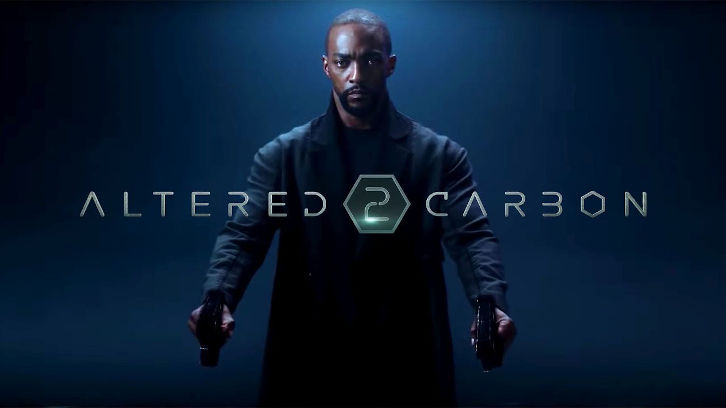
Note: This is a non-spoiler review of all ten episodes of Netflix's new sci-fi series Altered Carbon, which premieres Friday, February 2nd.
Altered Carbon is a pretty big swing for Netflix. Obviously seeing the potential in cyberpunk genre (which is undergoing a bit of resurgence right now), and always searching for a massive hit, they have tasked Laeta Kalogridis (Terminator: Genisys) to adapt Richard K. Morgan's novel of the same name to series. The ten-episode first season premieres on Friday, and it is sprawling, visually stunning, narratively jumbled, and incredibly ambitious. In other words, it's a bit of a mess, but it's a very watchable and admirable one.
Set in a future in which people's minds are transferred to their own personal "stacks", thus theoretically allowing people to live forever by swapping between different bodies (referred to as "sleeves"), Altered Carbon takes its premise to do what cyberpunk always does: analyze issues of class and greed through a dystopian lense. One thing these "stacks" have resulted in is making interstellar travel possible, leading to humanity spreading across the solar system and beyond. They has also lead to massive inequality, as the process of re-sleeving is expensive, and the ability to live forever is reserved for a very wealthy few, known as "Meths". In the world of Altered Carbon, the people of Earth are ruled over by an increasingly cruel and isolated group of immortal elites, who live high above the rest of humanity in their mansions in the sky.
Our hero is Takeshi Kovacs (played predominantly in this season by Joel Kinnaman, who is excellent). Kovacs is the last surviving member of the Envoys, a group of elite super-soldiers who rebelled against the UN on Kovacs' home planet Harlan's World. Kovacs' stack is removed and placed indefinitely in cold storage as punishment, until he is mysteriously pulled out by Laurens Bancroft (James Purefoy), a Meth on Earth who hires Kovacs to solve his own murder (Bancroft's murder was temporary given that Meths, in addition to having their own stacks like everyone else, are also backed up in the cloud).
Emulating the likes of Blade Runner, much of the first season of Altered Carbon plays like a piece of futuristic detective noir fiction, as Kovacs tries to uncover who killed his employer (it is widely believed that it was a suicide, but Bancroft himself is convinced that it wasn't). In his investigation he interacts primarily with Kristin Ortega (Martha Higareda), a San Francisco (now called Bay City)-based cop with her own secrets, as well as Bancroft's mysterious wife Miriam (Kristin Lehman), ex-soldier Vernon Elliot (the always great Ato Essandoh), and an AI hotel who takes the appearance of Edgar Allen Poe, played by Chris Conner.
The investigation is one of the least interesting things about the show, more interesting for how it allows Kovacs (and viewers) to explore the show's world than it is for the actual mystery of what happened to Bancroft. And at several points in the season the show seems to forget about the investigation entirely, whether by getting distracted by a cool bit of worldbuilding and then spending an episode focused on that, or by exploring Kovacs' past, in particular his relationships with his sister Reileen (a terrific Dichen Lachman) and his mentor/lover Quellcrist Falconer (a sorely underused Renee Elise Goldsberry).
I mentioned the worldbuilding, and it is perhaps the show's strongest feature, Netflix sparing no expense in making Altered Carbon's world feeling as immersive and well-realized as possible. But rarely does it feel like the show is stalling in order to show off, instead managing to integrate the worldbuilding rather smoothly into the plot (perhaps one exception to this is a needlessly extended subplot involving virtual torture early in the season, though it does have its purpose). And often the show manages to find a strange pathos while building out its world, such as an early episode which sees Ortega "spin back up" her grandmother into a new sleeve (that of a middle-aged man) for one night.
The show's look is established brilliantly by Miguel Sapochnik (who directed the first episode), and later directors do a solid job emulating his work. Each episode regularly contains a shot or sequence that is breathtaking in its beauty, though the production design is just as vital to that as the cinematography, if not more so.
Some might take issue with the show's pacing: it takes a while for the season (and some characters) to fully click, and too often does the show pause and move away from one thing to focus on another, hurting any flow or rhythm being generated. Altered Carbon is also not the most accessible to those who aren't already fans of the genre; the first few episodes in particular are filled with unexplained futuristic jargon that may prove impenetrable for more casual viewers.
But those who like this sort of thing (people like me) will probably really like this, and will soak up every little detail thrown at them. And the season also improves as it progresses, as more context is given to everything that is happening, and the two main plot strands of Kovacs' past and the Bancroft investigation are gradually brought together, building to a genuinely thrilling and action-packed climax.
Altered Carbon isn't perfect, and will likely not be the phenomenon Netflix is hoping it will be, if only because of how hard many casual fans will find it getting into it in the first place. But it's definitely a more than solid piece of genre television, and one that has the potential to someday be much more, if Netflix grants Kalogridis and co. more seasons.
Grade: B+
Sign Up for the SpoilerTV Newsletter where we talk all things TV!
Recommendations
Subscribe to:
Post Comments (Atom)



